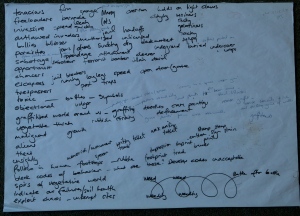Since the january assessment I have been putting my head into many books on weeds, research artist who use weeds or anything to do with weeds. With the aim to come to terms with the character of my muse and how my art can best reflect or interpret this creative influence. So far the character of my muse has not been placed in the best light. Most descriptions are slanted to the negative and many can’t agree what a weed is. The list of words so far collected that describe my muse is long, but can be broken into several groups, such as behaviour, traits, the odd positive and then some short descriptive sentences. Words that describe its behaviour can be; freeloaders, invasive, outlawed invader, bullies, parasites, sabotage, opportunist, chancers, human stalkers, exploiting chaos, rob/ruin/break codes of behaviour, loathsome properties, malignant, vulgar. Traits many weeds possess appear to be; tenacious, escapees, trespasses, toxic, objectional. Not too feel to down about them, some positives were found; foraged food, dyes made from them, symbol of resilience of life in face a of adversity, first vegetable, have remedies, thrive in company of humans, have an ecological part to play, indicators of soil health, provide an alternative for insects or can even be a host for beneficial insects. Or they can be described as;
- The spivs of the vegetable world,
- Uncultivated vegetable growth,
- Graffitised the world around ‘us’,
- Vegetable trash,
- Reduce productivity,
- Aliens,
- They represent human beings failures to master the soil and they grow abundantly where people have made mistakes, they simply indicate our errors and natures corrections (pg 11 Pfeiffer),
- Weeds exploit chaos,because they resists conditions that cultivated plants cannot handle, such as “drought, acidic soil, lack of humus and mineral deficiencies” (pg 11 Pfeiffer)
While my nose was in the ‘weed’ so to speak, 2 master pieces that used weeds as its subject came to the fore; In 1503 Albrecht Durer created an unusual master piece, ‘Great piece of turf’ (or sometimes also referred to as ‘The Large Piece of Turf’) This small but interesting painting provided a ‘tidy’ introduction to the world of the weeds. The composition appears to show little order, but there is great attention to detail, showing great realism of the subject. Realism was not necessarily what Durer was striving for, but he used this subject matter and approach for the development of his art. (wikipedia) Many of the weed types that he used for this painting still intrude into our everyday life today, here in NZ in 2014 they are considered to be an intruder into our ‘landscape’. This painting is a great archive of what was a ‘weed’ in 1503. It is such a simple painting and should be good inspiration. Also Still Life by Trajan Hughes from 1732 shows a small piece of ground, a display of a wide range of wildlife interacting around a foxglove in flower. This piece was harder to find a lot of info on and it appeared to also have an identity title crisis. As it appears under many titles. This work has as its main focus a flowering foxglove, with some bramble canes behind it, but it also contained a snake, bird & birds nest, a few butterflies and a frog. The relationship between all the elements that it contains is a puzzle, as the snake and birds nest feel very ‘placed’ in this work. Naturally there is no relationship between these elements, from that perspective, the title Still Life is very appropriate. As the items of this work have been ‘placed’ together to create the work, very much a vanitas approach. On a more contemporary level, Stephen Gill’s series, Talking to Ants has several images that uses plants/weeds. His approach of placing items in front of his camera lens and then photographing a scene, creates this multi layered image, much like a superimposed reality. The relationship between the photographed scene and the black, shadow like shapes creates an interesting dialogue. It creates the question; Which is superior? And What is the dialogue between the two layers? Which is real? This approach of Gill has room for investigation, as the character of my muse is anything but desirable or attractive. Possibly turning them into small silhouettes in front of a landscape or man made spaces could reflect the negative thoughts about these plants. The question does remain; How do you work with a muse whose qualities are described as anything but desirable or attractive? A brain storm using many of the words above and the thesaurus as an alternative is proving to be very helpful: 
Books:
Thompson, Ken. ( 2009) The book of weeds - how to deal with plants that behave badly. London, Great Brittain. Dorling Kindersley Ltd.
Pfeiffer, Ehrenfried. (2012) Weeds & What they tell us. Edinburgh.
Floris Books Edmonds, William (2013) weeds weeding (& Darwin) The gardener’s guide. London, Great Brittain. Francis Lincoln Ltd.
Webpages: http://en.wikipedia.org/wiki/Great_Piece_of_Turf http://en.wikipedia.org/wiki/Vanitas
